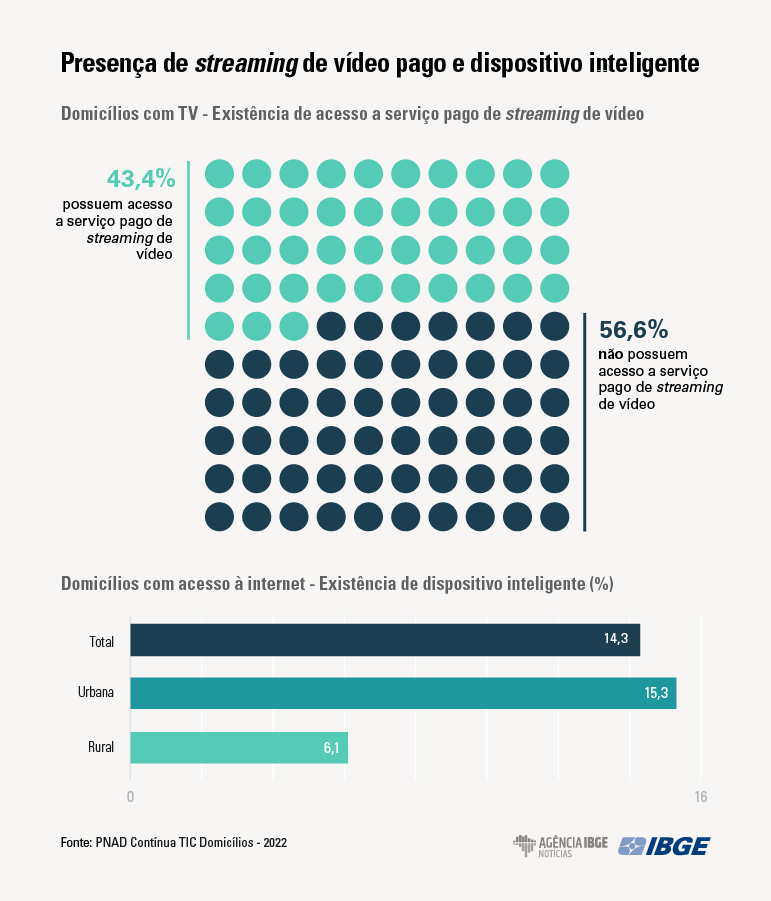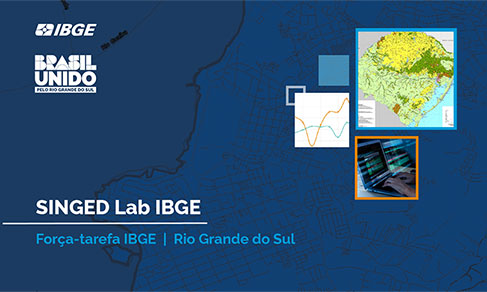Continuous PNAD
In 2022, 43.4% of households with a TV had streaming services
November 09, 2023 10h00 AM | Last Updated: November 14, 2023 02h43 PM
Highlights
- From 2021 to 2022, the number of households in the country with a TV rose from 69.6 million to 71.5 million, but the proportion of households with a TV fell from 95.5% to 94.9%.
- From 2021 to 2022, the percentage of households with pay TV ranged from 27.8% to 27.7%. The difference between the proportions of households with this service in urban areas (28.8%) and rural areas (19.8%) decreased from 25.3 pp in 2016 to 9.0 pp in 2022.
- Among households with TV, 43.4% (or 31.1 million) had a paid streaming service and 95.3% of these also accessed TV channels, whether open TV (93.1%) or pay TV (41.5 %).
- In 2022, among the country's households with a TV set, 16.0% (or 16.8 million) had an analog satellite dish.
- Around 1.3% (or 911 thousand) of households with television only had an analog satellite dish. The signal captured by this type of antenna will be discontinued in 2024.
- Around 56.5% of the country's households (or 42.6 million) had a radio in 2022.
- In 2022, of the 68.9 million households with Internet, 14.3% (or 9.9 million) had some type of smart device powered by the Internet, such as cameras, speakers, lamps, air conditioning, refrigerators, etc.
- The Internet was available in 91.5% of households in 2022, an increase of 1.5 percentage points (pp) compared to 2021, when 90.0% of households had access to it.
- From 2021 to 2022, the proportion of rural households with Internet grew from 74.7% to 78.1%, while in urban areas, this proportion was higher but grew less: from 92.3% to 93.5%. Consequently, the difference between the proportions of rural and urban households with this service was 40 pp in 2016 and fell to 15.4 pp in 2022.
- From 2021 to 2022, the percentage of households with Internet that used mobile broadband increased again, going from 79.2% to 81.2%, but remained lower than fixed broadband, which varied from 83.5% to 86. 4%.

The Internet was used in 91.5% of households (68.9 million) in the country in 2022, an increase of 1.5 percentage points compared to 2021. The growth of this proportion has been slowing down, as it reaches universalization. The expansion has been faster in rural areas, with a reduction in the difference compared to urban areas, from 40 pp in 2016 to 15.4 pp in 2022.
The data are from the Information and Communication Technology (ICT) Module of the Continuous PNAD, covering access to the Internet and television in homes and access to the Internet and ownership of a cell phone by persons aged 10 and over.

In Brazil, 6.4 million households without Internet
In 2022, 6.4 million households in the country did not have Internet. The three main reasons were: no resident knew how to use the Internet (32.1%), expensive Internet access service (28.8%) and lack of need to access the Internet (25.6%).
Other reasons given were: Internet access service was not available (5.4%), equipment to access the Internet was expensive (3.9%), lack of time (1.1%), concern about security (0. 6%) and other reasons (2.6%).
Broadband has been the main type of Internet connection in households, varying between 99.7% and 99.9% between 2016 and 2022. In 2021, the proportion of households with mobile broadband reduced, rising again in 2022. The adoption of fixed broadband grew throughout the series, surpassing mobile broadband in 2021 and 2022.
The lowest percentage of households with mobile broadband was in the Northeast (65.3%), while the other Major Regions exceeded 80%, with the Southeast leading (88.7%).
Smart devices are used in 14.3% of households with internet
In 2022, among the 68.9 million households with Internet, 14.3% (or 9.9 million) had some type of smart device that could be accessed through the Internet, such as cameras, speakers, light bulbs, air conditioning, refrigerators, etc. In the rural area, the percentage was 6.1% and in the urban area, 15.3%. Among the Major Regions, the lowest percentage was in the Northeast (9.9%) and the highest, in the South (18.2%).
Brazil has 71.5 million households with TV
From 2021 to 2022, the number of households with a TV set in the country rose from 69.6 million to 71.5 million. However, the proportion of households with a TV set fell from 95.5% to 94.4%. This occurred in all Major Regions and the biggest reduction was in the North: from 90.7% in 2021 to 89.9% in 2022.
This trend of increase in the number and decrease in the percentage of households with television occurred throughout the time series of the survey.
Analog satellite dish was still found in 16.8 million households
In 2022, there was an estimate of 65.5 million households receiving analog or digital open television signals, equivalent to 91.6% of households with TV in the country. In 23.5% of these households with TV sets there was a satellite dish (digital or analog) with an open signal. In rural areas, this percentage reached 54.8% and in urban areas, 19.2%.
In 16.0% (or 16.8 million) of the country's households with TVs, signal reception was via an analog satellite dish, compared to 8.3% (or 5.9 million) with a digital satellite dish of open signal. It is noteworthy that 1.3% of households with a TV (or 911 thousand) only received a signal via analog satellite dish.
“This group needs to migrate to reception via mini satellite dish, or they will be left without an open TV signal, due to the shutdown of transmission via analog satellite dishes. There are households with an analogue satellite dish, which also have other access devices such as pay TV, but this group of 911 thousand households only has this type of analogue satellite dish”, explains Leonardo Quesada, survey analyst.
Pay TV use declines in urban areas and grows in rural areas
In 2022, 27.7% of households with a television had access to pay TV, 28.8% in urban areas and 19.8% in rural areas. In urban areas, there was a drop of 0.4 pp in the proportion of households with this service (from 29.2% to 28.8%), while in rural areas there was an increase of 2.0 pp (from 17.8% to 19 .8%).
The Southeast Region (34.3%) has the highest percentage of households with pay TV and the Northeast, the lowest (17.1%).
“The proportion of households with pay TV in urban areas fell from 37.2% in 2016 to 28.8% in 2022. In rural areas, this proportion grew from 11.9% in 2016 to 19.8% in 2022 ”, highlights the analyst.
In 2022, among households without pay TV, 35.3% did not purchase this service because they considered it expensive and 53.7% were not interested. Around 9.2% did not have a pay TV service because they accessed videos (including shows, films or series) through the Internet, while 1.1% did not have the service where they lived.

Video streaming has already reached 43,4% of the houeseholds with TVs
Among households with a TV set, 43.4% (or 31.1 million) used some paid video streaming service. Among households with this service, 95.3% also accessed television channels, 93.1% on open TV and 41.5% on pay TV.
Only 4.7% of households with paid access to video streaming did not have open or pay TV. “This shows that streaming is still far from replacing more traditional forms of TV”, reinforces Mr. Quesada.

Proportion of households with a personal computer drops and tablet use rises slightly
From 2021 to 2022, the proportion of households with a personal computer fell from 40.7% to 40.2%. In 2016, this percentage was 45.9%. The proportion of households with a tablet, which had declined since 2016 (15.5%), rose from 9.9% (2021) to 10.7% (2022).
“This increase in the last period cannot yet be considered a change in the downward trend of tablets, as it will be necessary to follow new annual estimates to obtain a more clear panorama”, highlights the survey analyst.
Number of households with landline telephony continues to decline
The proportion of households with a landline telephone in the country was 12.3%, a drop of 3.3 percentage points compared to 2021 (15.6%). The rate of households with a cell phone (96.6%) increased compared to 2021 (96.3%). “In 2022, there was no telephone in just 2.8% of households (2.1 million), a reduction of 0.2 pp compared to 2021” highlights the analyst.
The percentage of households in the country with mobile cellular network service working for Internet or telephony increased from 86.2% in 2016 to 92.0% in 2022. In urban areas, this proportion increased from 89.7% to 95.2%, in the same period, and in rural areas, from 63.7% to 69.4%. “Since 2018, mobile telephony has expanded little in rural areas, showing a small drop between 2021 and 2022”, highlights the analyst.
Radio is still listened to in 56.5% of households in 2022
Around 56.5% of the country's households (or 42.6 million) had radios in 2022. The highest percentage was in the South Region (64.8%), while in the North and Central-West, less than half of the households (46.8% and 47.5% respectively) had radios. The percentage of households with this equipment in the rural area (58.2%) was slightly higher than that of the urban sector (56.3%).




















